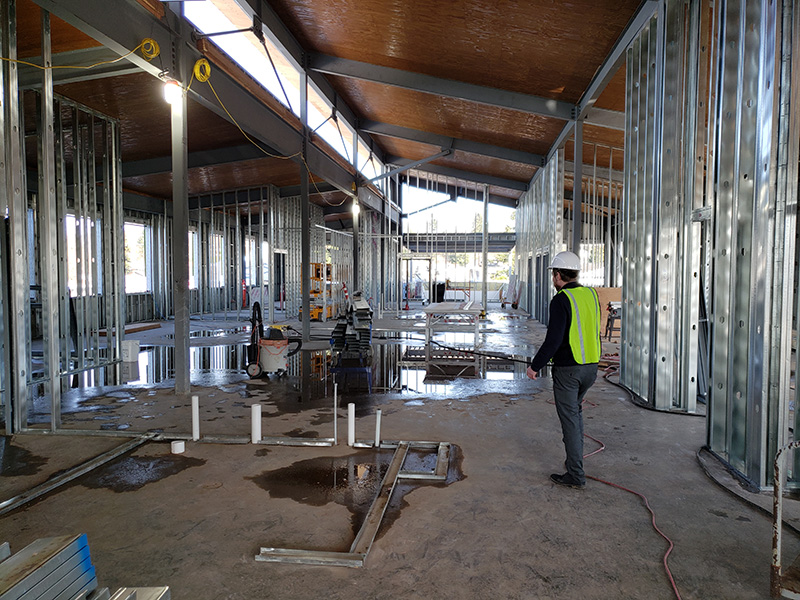By James Day
If you build it, other decisions will have to be made.
That’s the challenge the City of Silverton faces as construction heads toward the home stretch on the new Civic Center on the former Eugene Field School property.
The $19.5 million Civic Center project, which was opened to public tours March 16, is scheduled to be ready for occupancy in September. The new building was deemed necessary because the city had outgrown City Hall, which also is seismically unsafe. The new 26,000-square-foot two-story building will house city staff, including the Silverton Police Department, which will take up most of the first floor.

The addition of the Civic Center will have a trickle-down effect on a series of properties and institutions. Here is a quick snapshot from a City Council work session on March 20, which marked the first public discussion of the issues:
Old City Hall and the Fischer Building: Oddly enough the two buildings and the parking lot between them are in the same 18.5-acre tax lot as the library, the pool, Old Mill Park, the East Bank Trail and Coolidge McClaine Park. Thus, whatever the city decides to do with the properties, the land must be partitioned first, which means a bit of permitting and red tape, including title searches, surveying and utility investigations.
Community Center: The multi-tenant building where the council meets is owned by the State of Oregon and leased to the city. Silverton Area Community Aid and the Marion County Women, Infants and Children (WIC) program are moving north within the next year or so to the building formerly occupied by the Ratchet Brewery. YMCA programs also use the building. Councilor Marie Traeger said she has participated in four meetings on the subject and that “they want to build their own building.”
Eugene Field site: The Civic Center will occupy about half of the former school block. The remaining southerly portion of the 2.7-acre property has been the subject of much speculation as well as an informal public meeting hosted by City Manager Ron Chandler that focused mainly on parking issues. There will be 56 parking spaces at the Civic Center, about evenly split between staff-only spots in the rear of the building and public ones in front of it. City officials noted that the staff lot that will back up to A Street is not large enough to accommodate all city staffers and police vehicles.
Downtown business owners have encouraged the city to look at a blend of park space and parking with perhaps room for the farmers market at the south end. The Silverton Lions Club has spoken to the council twice about placing a gazebo there.
A 2018 city survey of more than 400 residents referenced by Chandler at the March 20 session noted the community’s top preferences for the property as a) a gathering space; b) preservation of trees; c) room for festivals; and d) a splash pad.
A Street property: The Eugene Field acreage included the informal dog park north of A Street near the Subway sandwich shop. The 0.75-acre site is in two parcels, with a utility easement running down the middle. Traeger suggested a number of possible uses, including pickleball, basketball and/or the farmers market. She also encouraged the city to look for potential donors/sponsors and noted the potential for revenue.
Depending on what happens at the south end of the Field site, parking also could wind up in the mix for the A Street site, although two councilors, President Elvi Cuellar Sutton and newcomer Eric Hammond, threw down the gauntlet on the issue, perhaps hinting at political challenges to come.
“Parking is a waste of resources,” Sutton said. “I’m happy to debate that all day. We need green space. We need gathering spaces. Can’t people walk a block?”
Mayor Jason Freilinger noted that the park-related questions could be part of the upcoming parks and recreation master plan work. Freilinger is expected to put forward candidates for an advisory committee that will tackle the plan at the April 3 council session.
Councilors at the March 20 session also discussed plans for street, storm water and sidewalk improvements in Mill Town in the northeast quadrant along Second Street. Bids will go out in mid-April on a $2.4 million project to add sidewalks, curbs and replace the storm water ditches on the 5-block stretch from the Home Place Restaurant to Lincoln Street.
The project includes road reconstruction, curbs and gutters on both sides of Second Street and sidewalks on the east side.
Also part of the project is a plan to “square off” the area near Mark Twain Elementary School where Whittier Street meets Mill Street with the goal of improving sightlines and boosting safety in the busy school-day corridor.
The city hopes to award the contract in June and complete construction in October.
Further down the road is a $5.9 million storm drain project on the streets that bisect Second – Lincoln, Jefferson, Washington, Chester and Whittier. The project also would repair cracks in the street and add curbs. No dates or funding sources for the project have been established.
Civic center financing
Starting in 2016 the city put aside about $1 million per year for the project. The funds were used to purchase the land, demolish the school and hire the design team. When the project moved to the construction phase, the city obtained a $10 million loan to finance the work. The annual debt service is $582,222 with a 3.17% fixed rate for 25 years. The intent of the project funding approach was to construct the building without raising taxes through a bond and keeping the budget impact consistent. The city received $600,000 in grants for design, energy modeling and a portion of the construction. The $19.5 million represents design and construction portion. The land acquisition and building demolition (around $1.8 million) is not included in that number.
Source: City of Silverton